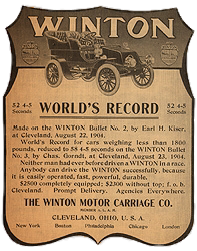ExcerptsIt's a FactIn Cleveland... After Alexander Winton produced his first horseless carriage in 1896, he was followed by many others. By 1930, 75 different nameplates had graced radiators of automobiles made in Cleveland. In 1904 the city was the nation's largest auto producer. Although Cleveland eventually lost the "Motor City" title to Detroit, Cleveland has long been the nation's second largest manufacturer of automotive components.
WantedWinton Automobile, Bicycle and diesel literature, postcards, letters, factory magazines; "The Auto Era," Ephemera, photos, miscellaneous memorabilia.
Bernie Golias |
PrologueThe weather in Cleveland on that mid-October morning of 1904 was as good as it gets at that time of the year when Lake Erie is maintaining some lingering warmth on its south shore. It must have seemed absolutely glorious to Alexander Winton as he stepped out the front door of his factory and looked up and down Berea Road. He was anxiously awaiting the arrival of Andrew Carnegie's chauffeur at any moment. Winton had dispatched one of his limousines to the railroad station to fetch the steel magnate's driver earlier that morning and the train had been on time. Now it was just a matter of waiting. The 24-horsepower Winton limousine Carnegie had ordered several months earlier was gassed and waiting, ready to make the trip to New York City where Carnegie now made his home. Carnegie had told Winton that he wanted to learn how to drive the car himself because he was curious about its operation. Nonetheless he conceded that it would be his chauffeur who would be doing most of the driving, including trips from his Fifth Avenue mansion to his country club on long Island. Being an experienced and enthusiastic automobilist himself, Winton was pleased that Carnegie had taken such a strong personal interest in his new machine, indicating that the two of them had a lot more in common than Scotland being the land of their birth. Winton could be proud of what he had achieved before and after founding the Winton Motor Carriage Company in 1897. Starting from nothing but enthusiasm and talent, the young Winton had started a bicycle repair business. He had built it into a world-renowned bicycle manufacturing company before he was 34 and started his carriage company before he was 37. |
He hadn't done this all by himself of course: his chief ally was Thomas Henderson, his brother-in-law, who had made Cleveland his home some time earlier. Henderson had helped young Winton get started in the bicycle business and, as we shall see, he was to remain Alexander's friend, confidant and business partner his entire life. Getting back to Winton's reverie on that October day of 1904, it's possible that he was still grieving over the tragic death of his wife one year earlier. She had either fallen or jumped from the 75-foot high cliff behind Roseneath, the Lake Avenue estate, during the early morning hours of August 28, 1903. Her body had been found floating in Lake Erie at daybreak by Charles B. Shanks, Winton's friend, advertising manager and publicist, who had rushed to the home when called by his distraught boss. It's also possible that by then Winton had perhaps found some solace in the fact that his widowed mother had come over from Scotland to care for his six children who ranged in age from three to nineteen. Her influence on him had always been strong, and he appreciated the fact that she had restored some sense of order to his life. But beyond the vicissitudes of his personal life, it's likely that Winton was now taking enormous pleasure in the prospect of having one of the richest men in the world take a personal interest in a Winton automobile. And rightly so! Twenty-five years younger than Carnegie, Winton was certainly not as wealthy, but at the time of Carnegie's visit his company was the largest producer of gasoline-powered automobiles in the United States! |

